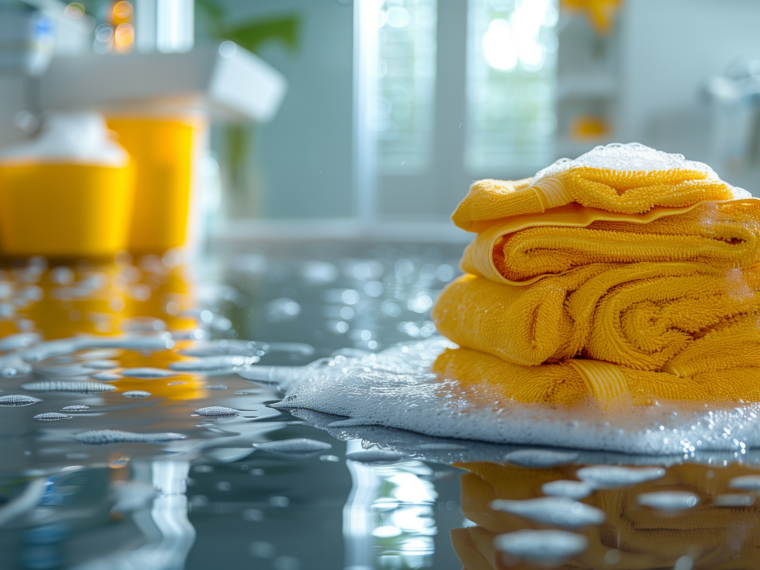Keeping a bathroom clean is essential for both hygiene and aesthetics. A well-maintained bathroom not only looks inviting but also helps prevent the spread of germs and bacteria. To ensure your bathroom remains a clean and pleasant space, regular cleaning is necessary. This guide provides an overview of the cleaning process to help you keep your bathroom in top condition.
Importance of a Clean Bathroom
Maintaining a clean bathroom is crucial for the health and well-being of everyone in the household. A dirty bathroom can harbor harmful bacteria and germs, leading to various health issues. Additionally, a clean bathroom is more inviting and comfortable to use, enhancing the overall experience.
Cleaning Process Overview
The cleaning process for a bathroom typically involves several steps, including cleaning surfaces, fixtures, and accessories. It is important to use appropriate cleaning products and tools to effectively remove dirt, grime, and bacteria. Regular maintenance tasks such as wiping down surfaces, scrubbing the toilet, and cleaning the shower or bathtub should be performed on a routine basis to ensure a clean and hygienic bathroom environment.
Before beginning the cleaning process, it is important to properly prepare the bathroom to ensure a thorough and efficient cleaning session. This involves two main steps: gathering the necessary cleaning supplies and removing personal items from the bathroom.
Gathering Necessary Cleaning Supplies
Firstly, it is essential to gather all the cleaning supplies needed to effectively clean the bathroom. This includes items such as a toilet brush, disinfectant cleaner, glass cleaner, scrubbing brushes, sponges, microfiber cloths, and gloves. Having all the necessary supplies on hand will help streamline the cleaning process and ensure that no time is wasted searching for items.
Removing Personal Items from the Bathroom
Prior to cleaning, it is advisable to remove any personal items from the bathroom. This includes toiletries, towels, bath mats, and any other items that may obstruct the cleaning process. By clearing the space of personal items, you will have better access to all surfaces and areas that need to be cleaned, allowing for a more thorough and effective cleaning session.
When it comes to cleaning and maintaining a bathroom, the sink and countertop are important areas that require regular attention. Start by clearing clutter and organizing items on the countertop to make cleaning easier. Remove any unnecessary items and store them in designated areas to keep the space tidy.
Using Appropriate Cleaning Products
Next, select appropriate cleaning products for the sink and countertop. Different surfaces may require specific cleaners to effectively remove dirt and grime without causing damage. For example, use a gentle cleaner for marble countertops and a disinfectant for the sink to kill germs.
Scrubbing and Disinfecting Surfaces
Once you have cleared clutter and chosen the right cleaning products, it’s time to scrub and disinfect the surfaces. Use a non-abrasive sponge or cloth to scrub the sink and countertop, paying special attention to any stains or buildup. Make sure to disinfect the surfaces thoroughly to kill any bacteria and viruses.
When it comes to cleaning the toilet, it is important to follow a few key steps to ensure that it is thoroughly cleaned and disinfected. Begin by preparing the toilet for cleaning by gathering all necessary supplies such as rubber gloves, toilet bowl cleaner, a toilet brush, and disinfectant spray. It is also a good idea to ventilate the bathroom by opening a window or turning on the exhaust fan to prevent inhaling any strong fumes.
Using Toilet Bowl Cleaner Effectively
Next, apply the toilet bowl cleaner to the inside of the bowl, making sure to cover all areas including under the rim. Allow the cleaner to sit for a few minutes to break down any stains or grime. Use a toilet brush to scrub the inside of the bowl, paying special attention to areas that may be more heavily soiled. Be sure to scrub under the rim and around the edges of the bowl to ensure a thorough clean.
Scrubbing and Disinfecting the Toilet
After scrubbing the inside of the bowl, flush the toilet to rinse away the cleaner. Then, spray disinfectant on the outside of the toilet, including the seat, lid, and handle. Use a clean cloth or paper towel to wipe down these surfaces, ensuring that all areas are thoroughly disinfected. Pay special attention to frequently touched areas such as the handle and seat to prevent the spread of germs.
When it comes to cleaning the shower and bathtub, there are a few key steps to follow to ensure they are sparkling clean. Start by removing soap scum and mildew from the surfaces using a suitable cleaner and a scrubbing brush. Pay special attention to areas where soap scum tends to build up, such as around the showerhead and on the walls.
Next, focus on cleaning the shower doors or curtains. If you have glass shower doors, use a glass cleaner to remove any water spots or soap residue. For shower curtains, remove them and wash them in the washing machine according to the care instructions.
Finally, don’t forget to scrub and rinse the bathtub thoroughly. Use a bathtub cleaner or a mixture of baking soda and vinegar to scrub away any grime or stains. Rinse the bathtub with water to remove any residue and leave it looking fresh and clean.
When it comes to cleaning the floors in your bathroom, there are a few key steps to follow in order to ensure they stay sparkling clean. Start by sweeping or vacuuming the floor to remove any loose dirt, hair, or debris that may have accumulated. This will make the mopping process much more effective.
Mopping with Appropriate Cleaning Solution
After sweeping or vacuuming, it’s time to mop the floors with an appropriate cleaning solution. Make sure to use a cleaner that is safe for the type of flooring you have in your bathroom. For tile or linoleum floors, a mild detergent mixed with water should do the trick. For hardwood floors, use a cleaner specifically designed for wood surfaces.
Cleaning Grout and Tile Surfaces
In addition to mopping the floors, it’s important to pay special attention to cleaning the grout and tile surfaces in your bathroom. Over time, grout can become discolored and tile surfaces can accumulate soap scum and grime. Use a grout brush and a mixture of baking soda and water to scrub the grout clean. For tile surfaces, a mixture of vinegar and water can help break down soap scum and leave your tiles looking shiny and new.
Proper Storage Solutions for Bathroom Essentials
One of the key aspects of maintaining a clean and organized bathroom is having proper storage solutions for all your essentials. Invest in storage baskets, shelves, and cabinets to keep items like towels, toiletries, and cleaning supplies neatly arranged and easily accessible. Utilize drawer organizers and dividers to keep smaller items like makeup and hair accessories in order. By having designated spaces for each item, you can prevent clutter and make it easier to find what you need.
Establishing a Regular Cleaning Routine
To ensure your bathroom stays clean and hygienic, it’s essential to establish a regular cleaning routine. Set aside time each week to thoroughly clean all surfaces, including the sink, toilet, shower, and floor. Use disinfectant cleaners to kill germs and prevent the buildup of mold and mildew. Don’t forget to wash shower curtains, bath mats, and towels regularly to maintain freshness. By staying on top of cleaning tasks, you can prevent dirt and grime from accumulating and maintain a sparkling bathroom.
Tips for Preventing Future Clutter and Mess
In addition to regular cleaning and proper storage solutions, there are several tips you can follow to prevent future clutter and mess in your bathroom. Encourage family members to put items back in their designated places after use to avoid leaving them out on countertops or floors. Consider decluttering regularly by getting rid of expired products, unused items, and old towels or linens. Invest in multi-purpose organizers and storage solutions to maximize space and keep everything in order. By implementing these tips, you can maintain a tidy and organized bathroom for the long term.
Frequently Asked Questions (FAQ)
[lightweight-accordion title=”What are some bathroom-friendly plants that can thrive in low light conditions?”]Some bathroom-friendly plants that can thrive in low light conditions include pothos, snake plants, and peace lilies.[/lightweight-accordion][lightweight-accordion title=”How can companion planting be beneficial for both plants and the bathroom environment?”]Companion planting in the bathroom can help deter pests, improve air quality, and create a harmonious plant ecosystem.[/lightweight-accordion][lightweight-accordion title=”What are the steps involved in using bio-compost as a natural fertilizer for bathroom plants?”]Using bio-compost involves collecting organic waste, allowing it to decompose, and then using the nutrient-rich compost to feed bathroom plants.[/lightweight-accordion][lightweight-accordion title=”What are some common misconceptions about using fertilizers on bathroom plants?”]One common misconception is that more fertilizer equals faster plant growth, when in reality, over-fertilizing can harm plants.[/lightweight-accordion][lightweight-accordion title=”How can the positioning of bathroom plants impact their growth and overall health?”]Placing bathroom plants in areas with adequate sunlight and proper ventilation can promote healthy growth and prevent issues like mold or pests.[/lightweight-accordion][lightweight-accordion title=”What are some different types of fertilizers that can be used to nourish bathroom plants?”]Some different types of fertilizers for bathroom plants include liquid fertilizers, slow-release pellets, and organic compost.[/lightweight-accordion][lightweight-accordion title=”Why is it important to regularly check bathroom plants for signs of pests or diseases?”]Regularly checking bathroom plants for pests or diseases can help prevent infestations and ensure the overall health of the plant ecosystem.[/lightweight-accordion][lightweight-accordion title=”What are some essential tools and materials needed for caring for bathroom plants?”]Essential tools and materials for caring for bathroom plants include watering cans, pruning shears, potting soil, and organic fertilizers.[/lightweight-accordion][lightweight-accordion title=”How can the process of composting be integrated into bathroom cleaning routines to benefit both plants and the environment?”]Integrating composting into bathroom cleaning routines can help reduce waste, nourish plants with nutrient-rich soil, and promote sustainability.[/lightweight-accordion][lightweight-accordion title=”What are some key factors to consider when selecting plants for a bathroom aesthetic?”]When selecting plants for a bathroom aesthetic, consider factors like light requirements, humidity levels, and the overall design theme of the space.[/lightweight-accordion]



